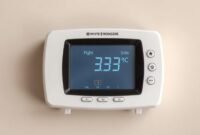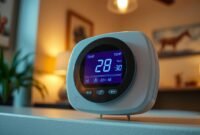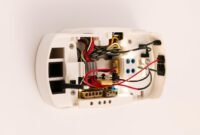Do you find your indoor air quality uncomfortable? Many people struggle with humidity issues that affect their comfort and health. Traditional thermostats can’t handle these complex needs.
Honeywell smart thermostats with humidity control are a game-changer. They offer precise control over your indoor climate. This is thanks to advanced sensors and smart monitoring of each room.
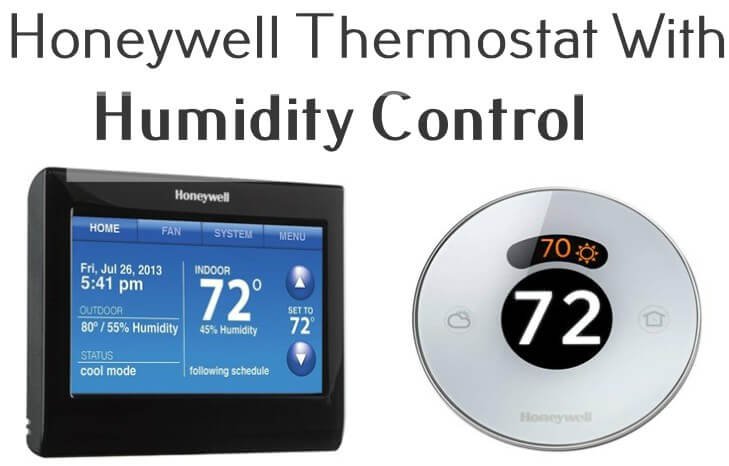
My research shows Honeywell’s lineup, like the T9 Smart Thermostat and VisionPRO 8000 Series, offers top-notch comfort. These thermostats improve your home’s air by controlling humidity and connecting wirelessly.
Read also: Honeywell Thermostat Connection Failure and Ways to Fix It
Understanding Honeywell Thermostat with Humidity Control
Managing indoor climate is more than just setting the temperature. Smart thermostat humidity control has changed how we enjoy our homes. Honeywell’s thermostats offer advanced humidity control, keeping your home just right.
Basic Principles of Humidity Control
Humidity control means keeping the right amount of moisture in your home’s air. Experts say the ideal humidity is between 30-50%. Honeywell’s smart systems use advanced sensors to keep it just right.
- Monitor indoor moisture levels in real-time
- Integrate with HVAC systems for precise adjustments
- Prevent excessive humidity or dryness
Why Humidity Control Matters
Controlling humidity is key for health, comfort, and keeping your home in good shape. Too much humidity can cause mold, while too little can lead to breathing problems and static. Honeywell’s systems help avoid these issues.
Key Benefits for Home Climate
Smart thermostat humidity control brings many benefits. You’ll breathe cleaner air, save energy, and enjoy even temperatures. Studies show you could save up to 10% on energy by keeping humidity levels just right.
- Reduce allergen and dust mite presence
- Protect wooden furniture and flooring
- Enhance overall home comfort
Choosing Honeywell thermostats with humidity control means a smarter, healthier home.
VisionPRO 8000 Series: Advanced Humidity Management
I’ve found the perfect solution for controlling your home’s climate with the VisionPRO 8000 Series thermostat. This advanced Honeywell device does more than just control temperature. It also manages humidity levels in your home.
The VisionPRO 8000 Series is known for its top-notch humidity management. It has sensors that can detect humidity levels. This lets homeowners control their home’s environment like never before.
- Energy Star Certified for maximum efficiency
- 7-day programmable mode with flexible settings
- Advanced humidification and dehumidification controls
- RedLINK wireless technology for remote monitoring
This thermostat is smartly designed. It has a touchscreen and battery backup. You can track many environmental factors at once. It shows important info like temperatures, humidity, and system status.
This Honeywell system is also easy to use with other devices. It works with up to 3 Heat/2 Cool Heat Pump Systems. Plus, it integrates well with home automation systems. Honeywell backs it with a 5-year warranty.
The thermostat is small and light, measuring 4.63 x 4.94 x 1.13 inches and weighing 2 lbs. It also has features like filter indicators and keypad lockout. These add to the user experience and protect the system.
Smart Features of T9 Thermostat with Humidity Sensing
The Honeywell smart thermostat T9 is a game-changer for home climate control. It brings top-notch tech to managing humidity and temperature.
Multi-Room Temperature Balancing
The T9’s standout feature is balancing temperatures in different rooms. It uses advanced sensors to control the climate in your whole home. This ensures comfort everywhere.
- Supports up to 20 room sensors
- Measures both temperature and humidity
- Detects room occupancy automatically
Smart Room Sensors Integration
The T9’s remote sensors are a big deal for precise climate control. You can place these sensors in various rooms for accurate readings.
| Sensor Feature | Details |
|---|---|
| Battery Life | Up to 1 year with standard AAA batteries |
| Additional Sensors | $74.99 per pair |
| Total Sensor Capacity | 20 sensors maximum |
Mobile App Connectivity
The T9 is great for controlling your home’s climate from anywhere. Its app lets you see temperature and humidity in real-time. You can adjust settings instantly.
- Compatible with Google, Amazon, and Cortana
- Geofencing feature saves up to 10% on energy bills
- Instant temperature and humidity tracking
The Honeywell T9 smart home thermostat changes how we manage indoor climate. It offers unmatched control and efficiency.
TH9320WF5003 Wi-Fi 9000: Color Touchscreen Innovation
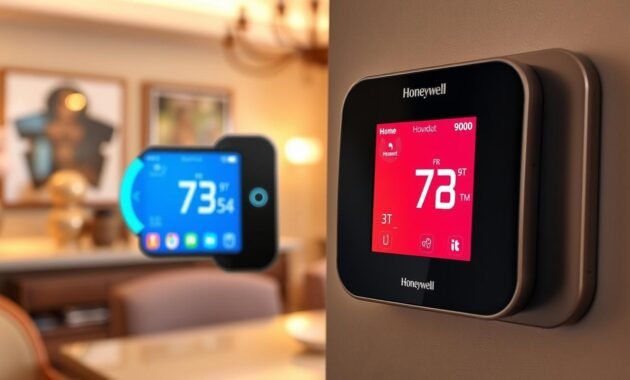
The Honeywell digital thermostat TH9320WF5003 Wi-Fi 9000 is a game-changer for smart homes. It brings new levels of control and convenience to managing your home’s climate.
Read also: How to Reset Honeywell Thermostat Old Model that Uses Battery Power
Some standout features of this Honeywell thermostat include:
- 8-inch color touchscreen display
- Wi-Fi enabled connectivity
- Advanced humidity sensing capabilities
- 7-day programmable scheduling
- Compatible with Alexa and Google Assistant
This thermostat’s design lets you control temperature and humidity with precision. You can see indoor and outdoor temperatures easily. The Total Connect Comfort app lets you manage your home’s energy from anywhere.
Read also: The Wait Phase of A Honeywell Thermostat
| Specification | Details |
|---|---|
| Model Number | TH9320WF5003 |
| Display Size | 8 inches |
| System Stages | 2 Heat/2 Cool |
| Connectivity | Wi-Fi Enabled |
| Warranty | 5 Years |
This Honeywell digital thermostat offers comfort and saves energy. It keeps your home at the perfect humidity all year.
RedLINK Technology and Wireless Accessories
Honeywell’s RedLINK wireless technology is a game-changer for home climate control. It offers unmatched connectivity and convenience. This system has strong wireless communication, better than traditional WiFi, for easy control of your home’s temperature and humidity.
The RedLINK wireless ecosystem adds smart features to your home’s heating and cooling. These accessories can make your home more comfortable and energy-efficient.
Compatible Add-ons for Redlink Wireless
- Internet Gateway for remote monitoring
- Wireless Indoor Air Sensor
- Wireless Outdoor Air Sensor
- Portable Comfort Control
- Equipment Interface Module
Wireless Control Options
Working with RedLINK accessories gives you great flexibility in managing your home’s climate. You can control it through smartphone apps, web interfaces, or dedicated remote controls.
Remote Monitoring Capabilities
| Feature | Capability |
|---|---|
| Temperature Control | Adjust settings from anywhere |
| Humidity Management | Monitor and regulate indoor moisture levels |
| Energy Tracking | View real-time energy consumption |
RedLINK technology from Honeywell lets homeowners create a smart home climate control system. It works well in multi-level homes or complex layouts. This wireless solution offers reliable, interference-free communication, keeping you connected to your home’s comfort.
Installation and Professional Setup Requirements
Setting up your Honeywell thermostat for the best humidity control needs a pro. DIY setups can be hard, even for simple systems. This is why professional installation is so important.
Experts in HVAC know how to install thermostats right. They handle the tricky wiring that’s key to your thermostat’s success. Here’s what you need for a good setup:
- Verify electrical system compatibility
- Check existing HVAC system configuration
- Ensure proper wire connection for humidity control
- Configure advanced humidity sensing features
Wiring for Honeywell thermostats can be complex. Dual-fuel systems need special care, with setups from two to ten wires. Most use five wires for controlling humidity and temperature.
Installation safety is a top priority. Always turn off power at the breaker and map your wiring carefully. Important steps include:
- Identifying terminal labels (R, RH, RC, C, G)
- Checking for line voltage indicators
- Confirming communication system compatibility
For top-notch humidity control, get a pro to install it. They’ll make sure features like variable speed blower and dehumidification work right. Professional setup boosts your home’s air quality and comfort.
Smart Home Integration and Ecosystem Compatibility
My Honeywell smart thermostat is at the top of home climate control tech. It makes your home smart and adaptable to your life. It turns your space into a smart, responsive place.
Voice Assistant Support
Now, controlling your thermostat is super easy. The Honeywell smart features work with voice assistants. You can change your home’s temperature with just your voice. You can talk to:
- Amazon Alexa
- Google Assistant
- Cortana
Third-Party Platform Integration
This smart thermostat connects different tech easily. It works with many platforms, making your home more connected:
- IFTTT (If This Then That)
- Samsung SmartThings
- Apple Home
Home Automation Features
This thermostat’s real strength is in home automation. It supports up to 20 sensors for custom routines. This improves comfort and saves energy in different rooms.
Key features include:
- Geofencing technology
- Remote temperature control
- Automated scheduling
- WiFi on both 2.4 and 5.0 GHz networks
With advanced tech and easy design, my Honeywell smart thermostat keeps your home comfy, efficient, and just right for you.
Energy Efficiency and Cost Savings Features
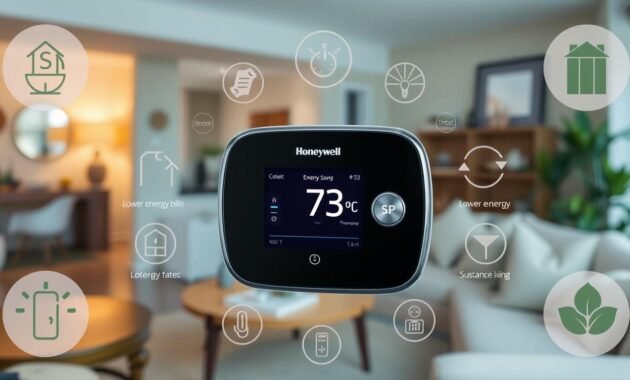
Honeywell’s energy-efficient thermostats are designed to cut down on energy use and lower bills. They use smart technology and monitor humidity levels to help you save energy. This way, you can keep your home comfortable without wasting energy.
Key energy-saving features include:
- Smart response technology that learns your temperature preferences
- Automatic geofencing for home/away scheduling
- Precise humidity levels tracking
- ENERGY STAR® certification
The Total Connect Comfort App lets you monitor your home’s energy use in real-time. You can adjust settings to make your system more efficient right away.
| Thermostat Model | Energy Savings | Price Range |
|---|---|---|
| WiFi Smart Color Thermostat | Up to 15% annually | $129-$149 |
| T9 Smart Thermostat | Up to 20% annually | $169-$199 |
| WiFi 9000 Color Touchscreen | Up to 25% annually | $199-$223 |
Choosing an energy-efficient thermostat with advanced humidity control can greatly reduce your energy use. It also keeps your home comfortable.
Comparing Different Honeywell Humidity Control Models
Finding the right thermostat with humidity control can be tough. I aim to guide you in comparing features and picking the best models for your home’s climate.
Price Range Comparison
Honeywell has a range of options at various prices. The T9 is around $200, perfect for small to medium homes. On the other hand, the T10 starts at $300, designed for more complex systems.
| Model | Price Range | Best For |
|---|---|---|
| T9 | $200 | Small to medium homes |
| T10 | $300+ | Large homes, complex systems |
| VisionPRO 8000 | $250-$350 | Advanced zoning |
Feature Set Analysis
When looking at programmable thermostat humidity features, focus on these key points:
- Sensor support capabilities
- Smart home integration
- Wireless connectivity
- Additional HVAC component control
Performance Metrics
Each model shines in different areas of humidity management. The VisionPRO 8000 Series excels in advanced zoning. The T9 is great for multi-room sensing.
The TH9320WF5003 Wi-Fi 9000 stands out with its color touchscreen. For complex systems, the T10 requires professional installation. It supports up to 20 sensors with RedLINK® 3.0 technology.
Conclusion
Exploring Honeywell thermostat features shows that indoor air quality is more than just temperature control. A good iaq thermostat can make your home more comfortable. It does this by controlling humidity levels, solving problems like dry air and too much moisture.
Honeywell’s humidity control thermostats offer smart solutions for any home. Models like the VisionPRO 8000 Series and the smart T9 have advanced tech. They learn your habits to manage the climate perfectly, saving energy too.
Choosing the right thermostat is about more than just temperature. It’s about creating a personalized comfort space. Look for features like smart home integration and room sensing. This way, you can find a Honeywell thermostat that fits your needs.
Investing in a smart humidity control system is good for your home and family. These thermostats come with professional installation and the latest tech. They are the future of managing your home’s climate.
